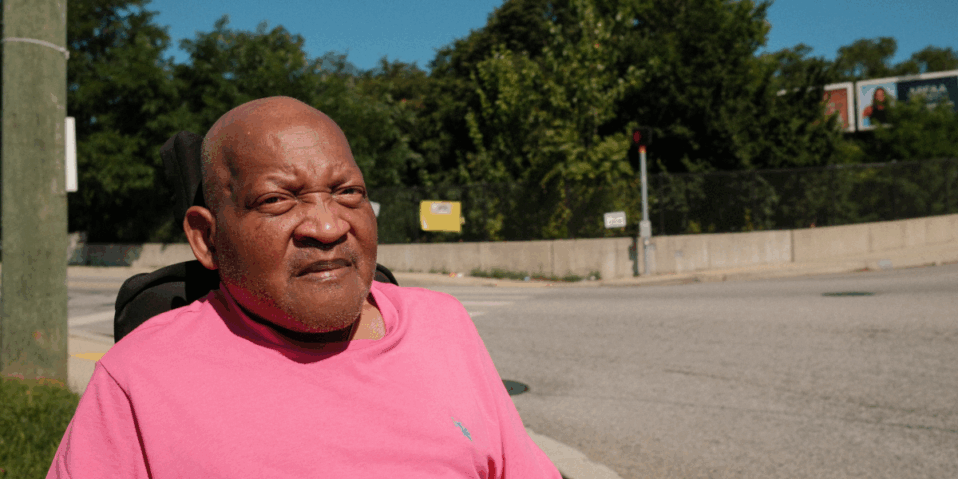How would your life be different if you couldn’t drive for a week? What if you had to take the bus, use the sidewalks (or streets as a pedestrian), or use paratransit to get around? Floyd Hartley, a 72-year-old Baltimore resident who uses a wheelchair, does just that. Floyd is the chairperson of the grassroots organization, Consumers for Accessible Ride Services (CARS) that is made up of paratransit riders/advocates seeking to improve services in the Baltimore metropolitan area.
Floyd’s experiences show us why more people should participate in Week Without Driving where advocates ask drivers to give up their cars for seven days and travel the way millions of Americans do every day. Floyd’s story helps us understand what really needs to change in our transportation system and that we can’t keep prioritizing cars.
Getting Around Baltimore in a Wheelchair
Floyd has been using the Maryland Transportation Administration’s paratransit service, MobilityLink, since 2004. Paratransit is a specialized transit service for people with disabilities who are unable to independently use fixed route transportation, like the bus or metro. MTA’s Mobility is a shared ride service that picks up its passengers at their door and drops them out at their requested destination. While this sounds convenient, Floyd’s daily travel is full of challenges most drivers never think about.
Just leaving his house is an adventure. Floyd lives near a busy street with no speed bumps. He has to travel through an alley to get to the main road, then navigate cracked sidewalks that are “bumpy, bumpy, bumpy all the way through.”
“There’s instances where you may find a pole that’s in the middle of the sidewalk that you have to navigate around or go in the street just to get back onto the sidewalk,” Floyd explains. Sometimes grass grows onto the sidewalk, creating another barrier. Many curb ramps are old and haven’t been replaced in years.
When Floyd reaches the major intersection near his home, he faces even bigger challenges. Cars come from four different directions, and drivers can turn right on red lights. “You really have to be on the lookout,” he says. There are no buttons to push for longer crossing times, no countdown timers, and no signs warning drivers that wheelchair users frequently cross there.
When Transportation Fails
Floyd’s transportation troubles don’t end with bad sidewalks. Even when he schedules a Mobility ride, things often go wrong. Mobility operators sometimes don’t follow instructions and get stuck in his narrow alley. When this happens, it can take an hour for a supervisor to help them get unstuck.
“I have missed appointments because of that,” Floyd says. A few months ago, he missed a doctor’s appointment when a driver got stuck and needed help backing out of the alley.
Sometimes the bus lifts break down. Floyd has been stuck halfway up in the air, waiting for someone to manually crank the lift so it works again. “It’s not a good feeling being stuck halfway up in the air,” he says.
The buses themselves are uncomfortable. Floyd says the ride is so bumpy and rough that he sometimes needs to take pain medication before or after traveling. “We all are hoping that they would get something [vehicles] with a lot better shocks on them because the ride is horrendous, trust me,” Floyd says.
Missing Out on Life
These transportation problems affect more than just Floyd’s ability to get to appointments. They change how he lives his life.
Floyd loves sports and used to participate in athletics when he was younger. There’s a youth football league in his neighborhood that he’d love to watch, but the sidewalk conditions and distance to bus stops make it too difficult to get there.
“It prevents me from going there,” Floyd says. “I find myself not going” to many places he’d like to visit.
Regular bus stops are too far apart, and the sidewalks between them are too damaged to navigate safely. Floyd often needs someone to come with him as extra eyes when he travels to busier areas.
PART 2:
What Would Change Everything
Floyd has clear ideas about what would make transportation work better for everyone. He suggests:
- Better sidewalks: Fix cracks and remove obstacles like poles and overgrown grass. Thankfully this request is already in the works thanks to a $44 Million partial agreement with the City of Baltimore to make sidewalks and curb ramps more accessible.
- Smarter traffic lights: Add countdown timers and buttons that give pedestrians more time to cross
- Warning signs: Put up signs that tell drivers to watch for wheelchair users
- Painted crosswalks: Use bright colors and clear markings to show where people cross
- Speed control: Add speed bumps and cameras in areas with lots of accidents
- Better vehicles: Use mobility vehicles that are smaller, more comfortable and secure for riders
“There could be some type of signal or device or something, or even a sign saying, beware, there are wheelchair users that use this particular area,” Floyd explains.
Floyd has been publicly advocating for these kinds of changes as the chairperson of Consumers for Accessible Ride Services (CARS), a grassroots organization of paratransit riders in the Baltimore area that advocate for improved service. He frequently meets with decision makers to discuss how to improve the transportation system.
What Decision Makers Would Learn
Floyd thinks elected officials and city planners would be surprised if they had to give up driving for a week. He explains, “They would notice things like, why is this pole in the middle of the walkway? Why are the sidewalks cracked up? Why aren’t there ramps? ”
It’s About Everyone’s Safety
Floyd wants people to understand that transportation problems affect everyone, not just people with disabilities. “This isn’t just about individuals who have wheelchairs or individuals who are disabled. It’s about an overall safety mechanism for everyone,” he says.
When sidewalks are broken and intersections are dangerous, they’re problems for parents with strollers, elderly people with walkers, kids going to school, and anyone who needs to walk or bike. Floyd points out that there are car accidents near his house all the time because the street design is unsafe.
How You Can Help
Floyd encourages people to get involved in making transportation better. He suggests:
- Participate in Week Without Driving: From Monday, September 29 – Sunday, October 5, 2025 challenge yourself not to drive to any of your activities (shopping, work, appointments, etc.) and experience what many have to navigate every day.
- Contact your representatives: Call your city council members and state legislators
- Report dangerous intersections and broken or inaccessible sidewalks: Baltimore City residents can use the city’s 311 system to report their concerns using city streets and sidewalks.
- Attend community meetings: Show up when elected officials visit your neighborhood
- Speak up all year long: Don’t just complain during election time
- Demand action: Hold politicians accountable for promises they make
“Go down to Annapolis,” Floyd says, referring to Maryland’s capital. “Have your voice heard. Not only that, your senators, your council people that are in your district, when they have community meetings throughout the neighborhoods, these things need to be heard.”
Floyd emphasizes that citizens need to keep pushing for change and holding officials accountable. “Don’t just show up and say what you will do, do what you’re going to do, do what you say you’re going to do.”
PART 3
Why Week Without Driving Matters
Floyd’s story shows why Week Without Driving is so important. When people give up their cars, they experience transportation the way millions of Americans do every day. They learn about barriers they never noticed before.
A truly accessible transportation system would help everyone. It would have:
- Multiple, reliable travel options
- Safe sidewalks and crosswalks
- Better public transit
- Smart traffic signals
- Clear signs and markings
- Emergency transportation options
Floyd hopes that when people participate in Week Without Driving, they’ll understand that transportation isn’t just about getting from point A to point B. It’s about having the freedom to work, see friends, go to church, watch sports, and live a full life in a safe way.
“Safety is the number one issue, not just for themselves, but it’s for everybody,” Floyd says.
Taking Action
Floyd has been working with the MTA and city officials for years to improve transportation. He and CARS meet quarterly with MTA staff to share ideas and push for changes. Some improvements have been made, like apps that show when buses will arrive, but bigger problems remain.
He still advocates for emergency backup systems when technology fails, better vehicle comfort, and immediate transportation for medical emergencies. Floyd also thinks riders should test new buses before transit agencies buy them.
The Big Picture
Floyd’s daily transportation challenges might seem like small problems, but they add up to something bigger. When people can’t get around safely and easily, they become isolated from their communities. They miss medical appointments, can’t participate in activities they enjoy, and lose opportunities for work and education.
Week Without Driving helps people understand these challenges by experiencing them firsthand. It shows how small changes—like fixing a sidewalk or adding a traffic signal—can make a huge difference in someone’s life.
Floyd’s message is simple: transportation affects everyone, and everyone deserves to move around safely and independently. When we make transportation work better for people with disabilities, we make it work better for everyone.
This Week Without Driving, take Floyd’s challenge. Leave your car keys at home and see your community through his eyes. You might be surprised by what you discover—and inspired to help make your city more accessible for everyone.

